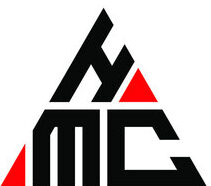Welcome back to The Not-So-Great Defector Bake Off, where Kelsey and Chris attempt to complete the technical challenges from the newest season of The Great British Bake Off, in their own home kitchens, with the same time parameters as the professional-grade bakers competing on the show.
They say the home bakers competing on The Great British Bake Off are too good now. Years and years ago, the producers of this program were picking from a crop of adorable amateur English bakers, people who just took up baking either as a family tradition or out of necessity or because they love to eat cake, and got good at it over a long time. These were regular schmoes who had developed a true baker’s intuitive, physical, alchemical sense of how flour, sugar, eggs, butter, water, and heat work in different combinations. Their expertise was niche, even folkloric. They knew without necessarily requiring any scientific knowledge what a properly mixed cake batter or properly kneaded bread dough feels like, how it moves and rests and breathes. There was no celebrity to be gained from baking; you came by your mastery somewhat more purely.
The competitors nowadays include many people who came into their baking prime in a world that already had The Great British Bake Off in it, and in many cases people who took up baking because of the show. These are people who might hate meringue but definitely understand the finer points of the methods for French, Italian, and Swiss varieties; who can recite the differences between a creme patissiere and a creme anglaise not just from having tinkered with the concepts but from having watched Mary Berry and Prue Leith taste and describe and critique dozens of different efforts; who in some cases knew that it was choux pastry and not shoe pastry months or even years before they ever actually ate the stuff. Baking in the post-Bake Off, post-pandemic world isn’t what it used to be! Former Bake Off champion Peter Sawkins got hooked into baking after watching a season of Bake Off when he was 12; Sawkins is now 24 years old.
Perhaps it is because of this dynamic that steel-eyed longtime Bake Off judge Paul Hollywood is becoming increasingly weird with his technical challenges. Twice already this season, Hollywood has declined to provide any instructions to the bakers. In Cake Week he assigned the bakers the challenge of producing miniature Battenberg cakes with nothing more than brief exposure to a finished Battenberg and a pile of ingredients. For Bread Week, Hollywood assigned the bakers the challenge of baking a seven-strand plaited wreath, with only a brief live demonstration of his desired braiding technique. Everything else that goes into making a good loaf of bread would have to come from the bakers’ own internal store of baking wisdoms.
Maybe the contestants of The Great British Bake Off are so good now that this is what it takes to really challenge their baking skills and knowledge. But we here at Defector are simple blogging idiots. Basically everything that we know about baking has been learned over the last two autumns of running this ridiculous stunt, and a solid 85 percent of that knowledge has been driven out of our brains by the requirements of doing daily blogs about baseball men who break our hearts. We vaguely remember how to braid hair; we maybe remember how to add salt and yeast to a pile of flour. If this is Hard mode for them, it’s Ultra Nightmare mode for us.
Kelsey McKinney: Our wishes have come true. Last week, we begged the gods (Paul Hollywood and Prue Leith) to allow us to make real bread, any real bread. And they allowed it.
Chris Thompson: They did! They asked us to make real-deal bread. Of course, they could not resist an opportunity to be weird and infuriating, but at least they stuck to the concept of bread for Bread Week.
KM: It’s wild! Bread for Bread Week?! Who could have imagined it!!
CT: The trick, this time, was that we would have no instructions whatsoever. All that we would know would be ingredients and then whatever we could remember of a short demonstration provided by Paul Hollywood, of the braiding method for building the loaf.
KM: Every week, another gimmick. Every week, another hell. I would like to confess something.
CT: I like confessions. Let’s hear it.
KM: I did not watch the Paul Hollywood tutorial. I watched a GIF of it on the Great British Bake Off Twitter feed.
CT: Kelsey! You did this bake from a damn GIF?!
KM: I know how to braid! I’m a good braider. I thought this was flawless, because I didn’t want to spoil myself for the rest of the episode by fast-forwarding through it. I could have asked my partner to do it, but I forgot and then it was too late and it was time to bake.
CT: I guess my impression, having now braided both hair and bread in my lifetime, is that these are not exactly the same tasks. Have you ever done a seven-strand braid of a person’s hair? That seems awfully extravagant.
KM: I have done fishtail braids, which are kind of like seven-stranded braids. And also, when have I ever been well-behaved in this column?
CT: It’s like you’ve built up all this goodwill by buying the appropriate ingredients a few weeks in a row, and then you ambush our readers with this maneuver. Real Dennis the Menace–type behavior.
KM: You’re right. I should apologize. But I think it’s important to note that we, as a company, had Monday of this week off. And I had to fly on a plane on Sunday, and drive to New York and back on Monday, so I had to do this bake Tuesday morning, and this was just the best we were gonna get.
CT: Sheesh, that’s a lot. OK, to me you are forgiven for declining to watch approximately 90 seconds of the television show.
Had you ever done any braided baking before this challenge? I had not.
KM: When I worked at a bakery in high school, one of the breads was challah! So I have made challah before, but it’s an enriched dough which is different!
CT: Mmmm … challah. Pillowy and eggy and delicious.
KM: I wish next week we got to make challah. It’s so soft.
Ingredients and Shopping
CT: Not too many ingredients this time! A pretty easy shopping list, for me. How’d you make out?
KM: Here’s another point at which I was well-behaved! I can’t believe it! When I got out all the ingredients we needed for this bake, I realized that my yeast was expired! I tested it in some warm water with honey and it did not bubble!
CT: Oh wow, so you replaced it? That is going the extra mile, my friend.
KM: Yes! I was already in my baking outfit with my sensible shoes and my hat to prevent hairs from getting in the bread, and I left my house (which I hate to do) to go to the corner store and get more yeast for this damn challenge!
CT: Did you have most of the rest of this stuff? Bread flour and olive oil and whatnot?
KM: Yes! I have a whole big thing of bread flour from when I used to go sourdough mode. Did you have all the ingredients? Or did you make a special trip?
CT: I grabbed a bag of bread flour because I knew I had very little left, and then it turned out that what I had left in the old bag was almost exactly what was required in the bake. But it wound up being a savvy purchase, because I needed a couple extra fingerfuls for dusting.
KM: Wow! Thank god! Very good job thinking ahead on this one!
CT: On the equipment side, obviously we did not have proving bags. To this day I have never seen a proving bag in person.
KM: Obviously! I cannot imagine purchasing one even if they were available. And we also do not have proving drawers like they have on the show, which historically has been quite a problem for us.
CT: Right. What kind of a person has a proving drawer in their home kitchen? Outrageous. Much more sensible to have a microwave and a space heater and several candles, which obviously can be used in combination to replicate the effects of a proving drawer.
KM: Must be nice! I can’t have a proving drawer, I need that space to store all my vinegar! I can use my heating pad and a space heater and two little sake cups to create a proving drawer environment! We are INNOVATING in the BAKING SPACE.
CT: Kelsey, before we get to the bake itself, I would like to ask you what you made of the epic-length 150 minutes that we were given for this bake. How did you feel about this?
KM: I felt that it was tight, incredibly. I remember when I saw that it was braided bread, I expected for some reason to be given three hours, maybe three hours and fifteen minutes. I’m not really sure why I thought that, but I wanted that amount of time. So 150 minutes felt very scant to me, even though it is a long portion of my life. What did you think?
CT: I often dread the very long bakes more than I do the very short ones. I figured that we would have a lot of time for sitting around in this bake, because bread dough famously needs to proof for a while. But the thought of being tied to a bake for hours and hours just fills me with anxiety. Also, if I’d gotten the notes and seen that we were given, like, 90 minutes, I would’ve screamed so loudly.
KM: Yes, exactly! Again, I felt very nervous to begin. There’s a kind of panic that settles in me right before we hit the stopwatches, and it always surprises me when it arrives.
CT: Oh yes. I can feel very confident in my ability to bake whatever thing we’ve been assigned, and then 25 minutes before the start of the bake, like clockwork, a huge wave of panic overtakes me and I become certain that I am going to somehow burn my home down.
KM: Yes. One exciting thing that is completely irrelevant to this story is that I bought myself a little canned tepache at the corner store, so I was sipping that the whole bake and it did make me feel better. Did you imbibe anything you would like to share?
CT: Well, yes, for the third week in a row, I consumed half of a THC gummy before the start of the bake. This time I think it didn’t do SHIT. Too much time!
KM: What? Now you’ll know for next time: one half per hour.
CT: Doctor’s orders!
Stage One: Making Dough, First Proof
CT: Kelsey, I believe when we started the timer this week you abstained from shouting “Fuck.” Was that a conscious choice?
KM: Wow. I did not consciously choose that! The thing is I feel much more confident about bread generally than the other baked goods, so I was calmer.
CT: What was your first item of business?
KM: First, I took the batteries out of my scale and put them back in.
CT: Genuinely hilarious to me that this is a necessary part of your baking process.
KM: The thing is, I don’t like buying stuff that I already have! I have money. I’m just dumb. Now that I know that if I put the bowl on it while it starts up, it will tare, I have far less incentive to get a new one! In the bowl I put: flour, salt, and yeast, and I mixed it up before adding wet stuff. Is that what you did?
CT: Yes. Well, first I measured flour into the bowl and then moved the bowl back to the other ingredients because I’d forgotten to take a photo. Forgetting to take photos was a theme of this bake, for me, I think because I was in such a panicky state of mind throughout.
I also did the thing where I put salt on one side and yeast on the other, because someone—possibly you—told me that this is Good Science.
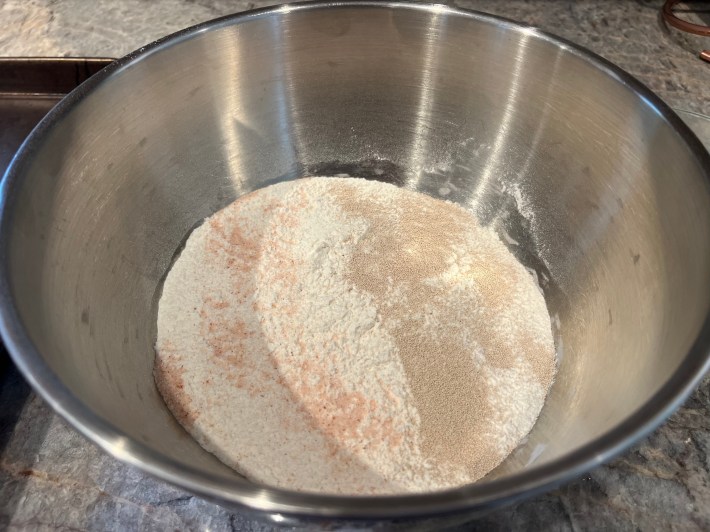
KM: Also, there was really no photos to take in this bake. There was only one thing to do, and all of it was just kind of boring aesthetically.
Oh I did the salt trick too! I always do that! I’m a woman in STEM.
CT: And then we had a cryptic message from my wive, who advised us that this bake would involve a quantity of water, but that we would only be using a portion of the water?
KM: What did you make of this? It confused me, to be honest.
CT: At first I just hoped that maybe it would be apparent where the water would be used. And then when I started to add the water to the flour it eventually did become apparent, because the initial pour was obviously not nearly enough water to make a coherent dough. But I was freaked out by the first pour, because I was like, “Why is my dough not working, WHAT IS HAPPENING.”
KM: Yeah, I still don’t know what we were supposed to do here. At first I assumed that the extra water would be for dipping our hands in to knead the sticky dough, but then after the first pour, there wasn’t enough water, so I just put all of it in. Whatever! With all the water it looked good. It was a dough ball.
CT: Yeah, it had that nice heavy feeling of a good dough blob. Kneading it was a treat. Love to knead.
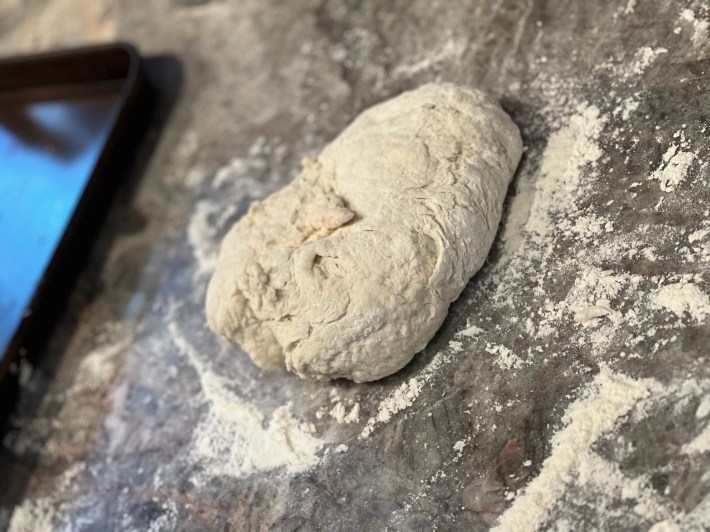
KM: I set a timer for 10 minutes to knead and told myself that either that or 500 kneads was when I would stop, whichever came first. I had literally no reasoning behind this. I just like to knead with my hands.
CT: I was hoping that I would pick up from the texture how long to knead. I also wanted to have the dough in the proving space within 15 minutes of the start of the bake. Proving was for sure the thing I was most freaked out about. So I probably did knead my dough for something like 11 or 12 minutes? I’m not sure. It happened fast.
KM: Yeah, I also wanted my dough proving in 15 minutes because I assumed immediately that there would be two proofs: one of the dough ball, and one after it became a braided wreath.
CT: There just weren’t enough steps of actual action in the bake, so obviously there had to be a LOT of proving. And if there’s a LOT of proving, then you immediately have to worry about Paul Hollywood smugly telling you that your bread is underproofed, in that damned accent of his.
What was your proving space like, for this first proof?
KM: I really do feel like I learned a lot from our disastrous attempt at panettone that first year. And one of the things that I learned was that your bread needs to be toasty girl.

So I put my bread in a glass bowl, and I preheated the oven to 500 degrees, and I put the bowl on the stovetop where it’s warm, and then I put a heating pad on top of it! And whenever I felt it was becoming too cool, I would open the oven for a minute. Do not yell at me about carbon monoxide! I have a carbon monoxide detector!

CT: Detector is what I’m going to name my Defector knock-off website after I get fired from this place for too many Nats blogs. Did you use any kind of thermometer for this phase? I had a meat thermometer that I deployed for my proving, which took place inside of my microwave, aided by a mug of steaming water and a tiny tea light candle.
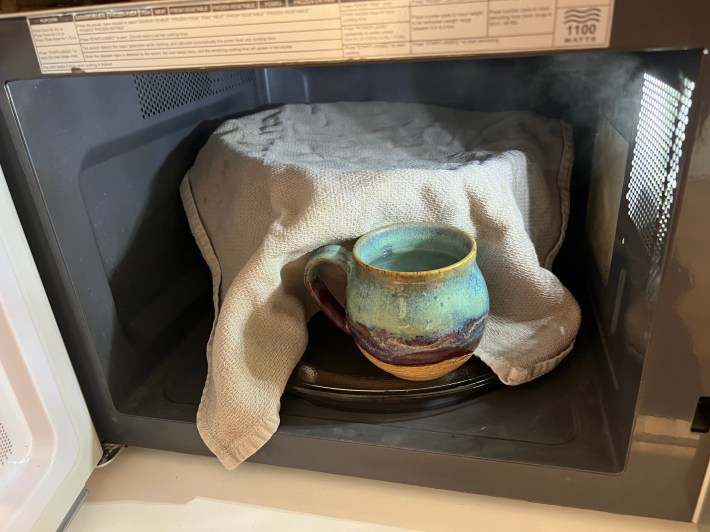
This was also a method that I picked up from the panettone bake, when guest baker Dayna Evans advised that the optimal temperature for proving is somewhere around 83 degrees.
KM: Remember when you proofed in the bathroom?
CT: Listen. A home baker will do desperate things for perfect buns.
KM: I’m just saying, we really have improved! Our instincts are better now than before.
CT: It’s so true! I felt very cool knowing that I had an established method for proving bread dough. And I had an easy enough time keeping the temperature basically within range, by opening and shutting the microwave door.
We did start to get spooked after about 30 minutes or so of proving. Our chat logs show a conversation moving from casual to frantic as we both battled anxiety and boredom.

KM: I was really surprised by how the time stretched itself out and allowed us to fill it with terror and fear.

CT: I was running into the problem of not really being able to see my dough because of the confined space, and not wanting to pull it out because I didn’t want to disrupt the environment.
At one point you mentioned that your dough was puffing up and I was instantly just filled with panic, because I’d only taken one peek at my dough and did not feel at all that it had risen much.
KM: I was trying really, really hard not to peek at my dough so that it could remain cozy in its proving bed. But I did check it at the 30-minute mark. At this point, I had not remembered that overproving was something to be afraid of, so I decided it could proof more and didn’t worry about it until later, when I worried a lot.
CT: God. Overproving is such a trap. Because naturally your instincts as a home-baker will tell you to just let it go longer, but if that sucker starts to deflate in there, you’re screwed. Screwed! And I simply do not have the baking chops to identify whether that process has started.
KM: Screwed! I will also say that because we had so much time, we did more crosstalk than usual. Usually our logs are just us typing “FUCK” and “my cakes are in” over and over again, but because we had more time, we could chat a little, which was great because I was reminded that things like overproving exist to be afraid of. Do you think we were right to determine that crosstalk is fine?
CT: Yes! You reminded me in there that the bakers in the tent are not forbidden from talking to one another, and they do it all the time. We’re only human!
We had time during this first round of proving to cause ourselves to freak out about the question of whether or not to preheat our baking sheets. That’s not something that ever would’ve happened in one of those quick biscuit bakes, where we’re mostly just howling expletives at one another and sobbing.
KM: We really freaked out about that! But for crusty bread you absolutely want the thing it’s going on to be hot! We debated it for a bit, but then decided that we wouldn’t want to move the bread once it was braided, so we wouldn’t pre-heat. To be clear, we were doing none of that for at least an hour, but we were still freaking out about it.
CT: Right, you made the sensible point that it would be best to braid the dough right there on the baking sheet, and then naturally you’d want to prove it on there as well. That settled it, for me.
KM: Oh. I actually did not even consider braiding the dough on the baking sheet! That would have been smart, if that had been how I understood my own idea. Sadly it was not. I braided on the counter.
CT: Oh no! So by misunderstanding what you were saying, I arrived at a sensible solution. That’s divine intervention.
Stage Two: Rolling and Braiding Ropes of Dough, Forming the Wreath
CT: I wasn’t sure that my dough was finished proving, but after it had been in there for more than 40 minutes, I just could not wait any longer. I think you pulled yours out moments earlier, and caused me to flip out and worry about losing too much time.
KM: Yeah, I peeked at my dough at the 40-minute mark and it looked very puffy. I poked it with my finger and it looked ready, so I took it out of the bowl.
CT: What was your method for dividing it into seven parts? Did you go math mode and weigh it?
KM: HAHAHAHA! Well, I did go math mode, but I also went stupid mode. What I did was divide 500 (the grams of flour) by seven. This math is wrong because there was also salt and yeast and water in there. So I ended up with like five pretty small balls before realizing it was wrong and then I had to shove balls together to get it right. So the second time I did it by eye.
CT: Oh my God! A nightmare! I think if I’d had to redo any step at this stage I would’ve vomited. I simply weighed the dough blob and divided it by seven, then cut the dough balls to that weight.
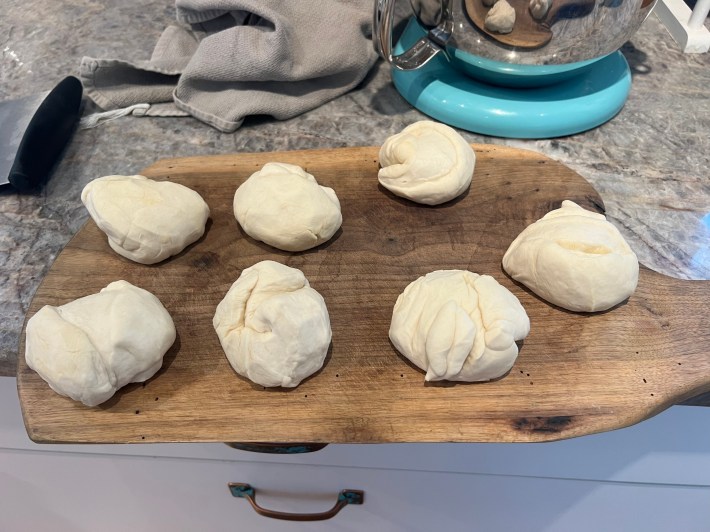
I did find that the rolling of the strands of dough was frustrating and physically exhausting. Perhaps I just have baby arms but I felt like the elasticity of my dough was constantly getting the better of me.
KM: I also found it exhausting but I kind of liked it. I always really liked making coil pots, and making the long strands was kind of the same except WAY more annoying because of the elasticity. I decided that I felt in my heart that the strands should be forearm length, so that’s what I did. How long were your strands?
CT: I was really freaked out about this! For a period of a few minutes, I was so hung up on the fact that this seemed like a key piece of information that we’d been denied, without which we could not hope to succeed. But in Paul’s demonstration his strands appeared to be approximately thumb width, and I just figured if I measured my dough balls evenly and then rolled each one to about thumb width, they’d be whatever length but at least they’d all be the same. Obviously typing it out like this it’s just, uhh, the very most basic and obvious statement in history. But at this stage of the bake it was like trying to solve some complicated trigonometric equation.
KM: I think that was totally reasonable and makes perfect sense to me! I was just rolling to what felt like a satisfying length, because I love to braid. When I was a child, they did not make the softball helmets that have the hole for a ponytail in the back yet. And so everyone braided their hair to wear the helmets. And I became very, very good at braiding. And being a good braider is a form of currency amongst elementary- and middle-school girls, so I have a lot of practice. I like doing it. It feels peaceful. I would have braided seven five-foot-long bread rolls if I could have.
CT: I have vague memories of being very small and sitting behind my mom on the floor and brushing and braiding her hair. But I think it had probably been several decades since the last time I braided anything. I was very grateful for Paul’s video!
KM: Did you feel nervous when you began braiding? Or did you like it?
CT: I felt nervous. Like, I understood the method, but I also assumed that there was dexterity and muscle memory in Paul’s baker’s fingers that could account for how easy he made it seem, and that my stupid blogger’s fingers would not be up to the job. So I started slowly, I think out of a fear of really committing to it in such a way that I couldn’t undo it.
KM: Oh no, Chris! That’s stressful! Once I began braiding, I did feel sad that all of my ropes were not exactly the same width the whole way down. I just felt that we did not have all the time in the world and that it was important to be fast in this phase so that the braid could prove a long time. So I was going really, really fast.
CT: I did start to feel like I had the hang of it, and in fact after I flipped it over I noticed that one half of it was really tight and lovely and the other half was loose and sloppy, and I couldn’t leave it like that. So I undid a portion of it and re-braided it. I just couldn’t bear for the finished product to look so uneven, it honestly would’ve bothered me less if both halves had been sloppy.
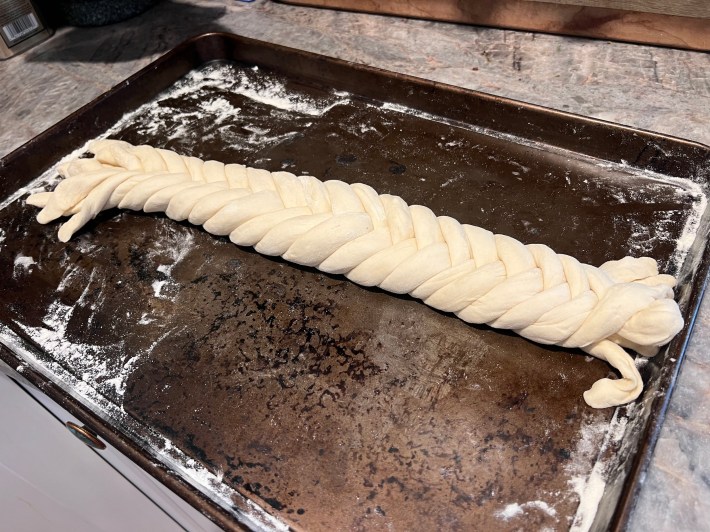
KM: I really wish I had done that. The top half of my braid was so much worse than the bottom because I wasn’t pulling it as taut, but I just left it because of my fear of the time. This is where my failure to watch the demonstration video really came into play because I had no idea at all how to connect the ends of the braid together.
CT: Ah man, yeah, and that wound up being much simpler than what I would’ve come up with on my own.
KM: What were we supposed to do?
CT: Paul just asked us to snip off the loose ends on both sides and kind of, like, pinch the two clean cuts together.
KM: HAHAHA! OK that makes perfect sense. What I tried to do was braid the braid ends together, which did not work at all and was also much skinnier than the rest of my loaf.
CT: Oh man. On the other hand, if you’d pulled that off it would’ve been an all-timer of a baking feat. How did you feel about your bread at this stage, having braided it and made a circle? Were you feeling pretty confident?
KM: I was feeling pretty confident. I really did not like the way the attached part of the bread looked, but I really did not think I had time to try something else. I wanted my bread to be warm again and it was so cold! How were you feeling?
CT: I felt great about how my bread looked, but I felt very worried that I’d manhandled it during the rolling of the strands, and that it had spent WAY too much time out in the cool ambient conditions of my kitchen, and so I was pretty desperate to get it back into a warm space.
KM: I also worried about this, but what I learned is that the instant yeast in this recipe is pretty forgiving!
CT: Yeah! Or, at any rate, it sure does make bread!
Stage Three: The Second Proof
CT: What was your setup like for the second proving phase?
KM: A problem immediately arose for me in the second proof, which is that my braid was now on the baking sheet and not in a glass bowl. When it was in the bowl I could just put the heating pad on top of it, but I didn’t want to restrict the growth of the loaf, and I wanted the heating pad close to the braid. So I looked all around my kitchen and found two little glass jars that had pandas on them and had previously contained sake, and I put those on either side of the bread and put the heating pad on top.

What was your setup?
CT: I love the improvisation of the panda jars. Both clean and festive.
I don’t know why it never occurred to me before the start of the second proof that I would need a much bigger space for proving. I really did not want to return to bathroom mode.
KM: Oh right. The classic problem: Microwave does not fit baking sheet.
CT: Yeah, not even close! And my oven, by this point, was preheating (which was probably premature, although you never can tell with my oven). So I looked around and my eye settled on the dishwasher. It has certain advantages: It’s confined but large enough to hold a baking sheet; its surfaces are made to withstand heat; and it was at that moment empty of dishes, because I like to start each bake with a completely reset kitchen.
KM: I want to admit that when you said dishwasher in our cross-talk chat, I had no idea what you were using it for and was kind of afraid. But you seemed confident!
CT: I mean, it worked pretty well! I wound up having to put two mugs and a bowl of steaming water in there, plus two tealights and a full-size candle, but eventually I got it up over 80 degrees. If I’d thought of it sooner it might’ve been perfect, but my dough unfortunately had to spend like 10 minutes in there in relatively cool air while I ran around grabbing hot things.
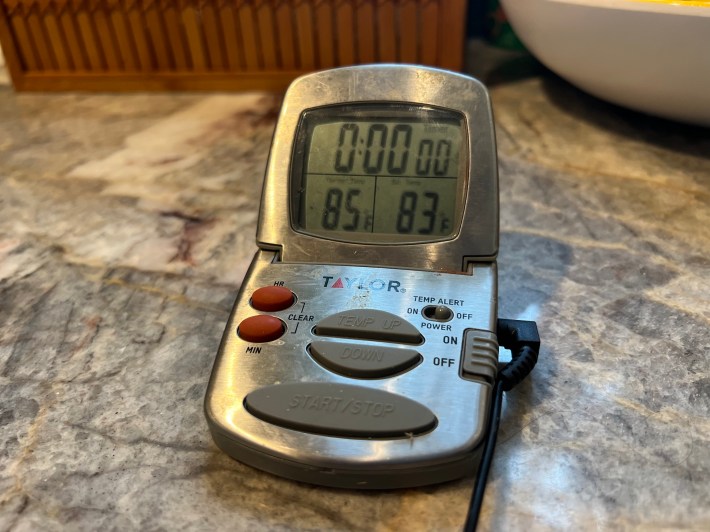
KM: It’s so funny that we are always doing this challenge in the fall, when our houses are maybe the coldest they will ever be, and so this is always a nightmare. Like in the summer, I would have just taken the bread outside for a bit! Let it get toasty in nature!
CT: That’s right! And in winter, the heat would be running! But in autumn, it’s nice to have cool air around and to be in sweater mode!
KM: Exactly! My windows are open! I have my hot water to drink. I love it.
CT: These damn contestants and their stupid proving drawers and bags. Go to hell!
KM: AND their production assistants cleaning their stuff! Though I will say this was definitely the cleanest my kitchen has ever been.
CT: Oh yeah, a very clean bake. Lots of time for anxiety-cleaning.
KM: Speaking of anxiety, how did you feel during the second proof? I felt awful and terrified and also nervous.
CT: At first I just felt very relieved to have a nice-looking loaf of dough in a proving space with lots of time on the clock. But very quickly this all warped into terrible anxiety. Too much time! Time enough to worry that maybe there was too much of it. Like, I really started to panic that we were going to finish early and have sad, flat, underproofed loaves, after all of that work.
KM: I felt in my bones that the second proof needed to be equal in time at least to the first proof, and I knew that proof was 40 minutes long. But that did not keep me from beginning to panic and worry around the fifteen minute mark. The idea of having an underproofed sad little flat loaf at the end of this was so upsetting.
CT: I like the symmetry of equal proving stages. Also, because the dough had been roughly handled and was now configured in a tight braid, it makes sense that the dough would need at least as much time for rising in this second phase. But even then, I would subtract the 40-ish minutes from the remaining time and come up with, like 35 minutes, and that just seemed like an insanely long amount of time for baking a loaf of bread. Somehow I felt that we had too much time for baking and also not enough time for proving.
KM: This is really when we began to freak out. Because we both wanted our bread to proof as long as possible before going in, and also we were scared because the clock is ticking down and you cannot stop it, and you need to wait until the last possible minute to throw your bread in the oven.
CT: Right! And also there would be the minor step of egg-washing our loaves, which obviously would happen quickly, but if you cut it too close and anything at all delays your process you’d be irrevocably screwed. It seemed like we were zeroing in on like three to five minutes of transition from proving to baking, but it was all coming to a head too fast. Too fast!
KM: It was all very mundane and very scary. Ultimately, I got to a point where my body was too upset to listen to my brain, and I decided it was time for my bread to be egg washed. According to the logs I put it into my 500-degree oven with 29 minutes to go.
CT: I did not feel that my bread had risen enough, but the clock was just so pitiless. I eventually yanked my dough out of the dishwasher and got it into a 450-degree oven with 26 minutes on the clock.
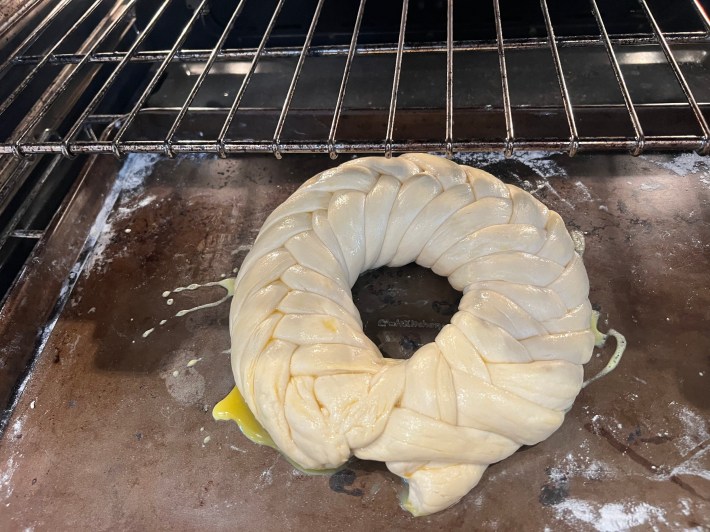
My biggest concern, at this stage, was that I had actually jumped the gun by a few minutes, and my notoriously too-hot oven would finish baking the bread with important minutes to spare.
KM: I also had a scare because I could not see through the window of my oven, on account of it being covered with grime.
CT: Ah, here is where we both have to confess that our oven windows are gnarly as hell.
KM: We had so much time that you tried to learn how to clean them!
CT: I learned that oven cleaner is terrifying and must not be handled by anyone, except for those scary guys in white HAZMAT suits who come to evacuate a town after a nuclear accident.
Stage Four: Baking
KM: The whole time my bread was baking, I was scared. I was frantically cleaning stuff and walking around. I went upstairs to move my laundry and that’s when I smelled something burning. This was so scary. I sprinted back downstairs to the kitchen, but then it was just the egg wash! No need to panic!
CT: Oh Jesus. The burning smell got me, too. For this bake I made the bold decision to test my terrible oven’s Convection Bake mode, reasoning that its purpose is to distribute heat more evenly, at the cost of a somewhat more turbulent baking environment. But when I smelled that char, I was sure that this piece-of-shit appliance from hell had owned me once again.
KM: This was so brave. Convection scares me because I fear what I don’t understand.
CT: Honestly, even after reading about it and using it I still do not understand it. It is illegal to lecture me about baking modes in the comments under this blog! Do not do it!
KM: Illegal!
CT: The inability to look in the window and see my loaf was driving me crazy. You?
KM: I was literally peering through like a single hole in the grime of my oven window trying to see if my loaf was growing and becoming a beautiful golden girl. Unfortunately, I could not tell anything at all.
CT: I would like to know the name of the ASSHOLE who decided to install a golden-colored oven light inside of my damn oven.
KM: YEAH! Like I get it: It’s a flattering light. But it’s really misleading!
CT: How are you supposed to know what is the real golden color and what is the fake one? It’s bullshit.
I did allow myself two peeks inside the oven, in order to turn my loaf and to gauge its progress. Frankly I am just not able to trust my oven and I was not willing to leave my loaf in there to burn. I discovered along the way that, in a hilarious twist, my oven was actually too cool, for a change.
KM: This has never happened before!
CT: It’s the convection setting! Gotta be! And it was actually heating pretty evenly, with just a little bit of extra heat toward the back. I think I could even have gotten away with not rotating my loaf, except that the joint where the circle was closed was noticeably thinner than the rest of the loaf, and was for a time in the hottest part of the oven.
KM: This is huge news. A game-changer even! I also opened my oven when I thought it was burning and turned it around, to make it cook evenly. It’s so funny that ovens just cannot heat evenly universally. Every oven is unique.
CT: This is an ANCIENT technology. Mankind simply must do better with this.
KM: When did you decide to pull your bread?
CT: Well, you and I were chatting and growing more and more anxious, and I suddenly looked at the timer and saw that we had only three minutes left, and then just seconds later you announced that you’d boldly removed your loaf from the oven. But my last look at my bread had given me the strong impression that it was not finished baking, so I did not pull mine until the final 10 seconds.
KM: Yes, I pulled mine with three minutes and those whole three minutes I seethed because I knew that was three more minutes that my bread could have been proving. I was so angry to have wasted those precious minutes. But my bread looked good and was golden!
CT: When you went to the oven with three minutes left, was it to pull the bread or to check on it? Were you pretty resolved?
KM: It was to check, but I noticed that it was getting pretty dark brown on the thin part where the wreath joined together, so I worried that it would burn if I left it any longer, and pulled it. How did you feel pulling yours out?
CT: I knew immediately that it was not finished to my satisfaction. I didn’t even bother turning the oven off, because I knew that if I wanted to enjoy eating this bread it would need to go back into the oven for a few more minutes.
KM: One of the huge benefits of bread is that we can complete our challenge at the time limit, take a pic, and then put the bread back in, because Paul Hollywood is not here and he is not our boss!
CT: Yeah! Eat it, Paul!
The Finished Product
CT: So! How did you feel about your finished loaf?
KM: I felt a little annoyed. Almost immediately after my bread came out, I realized that I should have put a cup or something in the middle while it proofed to keep that shape a perfect circle, and instead mine was a wobbly shape, but I also felt happy because it smelled like bread. How did you feel?
CT: It was soooooo nice to have the smell of fresh-baked bread in my kitchen.
I felt annoyed that my bread wasn’t fully baked, but I was very happy with the look of it, and in particular I was happy that my maligned and evil-ish oven had not burned it to a cinder.
KM: Show bread?
CT: OK, here is what my bread looked like the first time I pulled it from the oven. You can see that it is not fully golden.
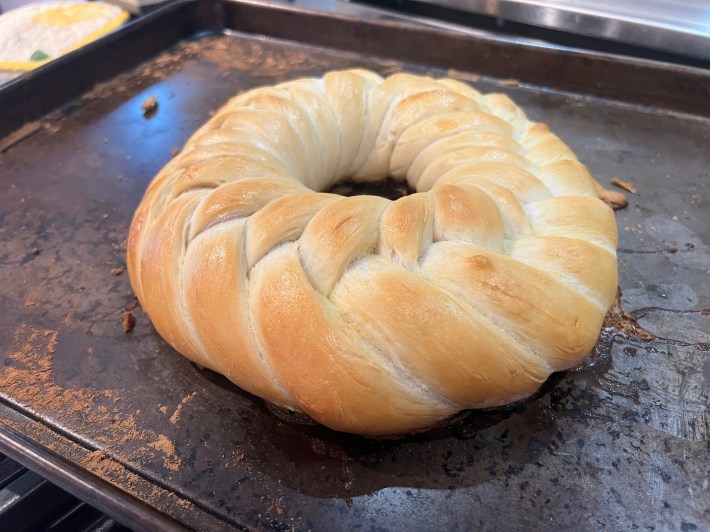
KM: Wow! I have to be honest: This is such a beautiful braid. I love the shape of this loaf. I do wonder why the inner circle got puffier than the outer circle, but I find that very appealing.
CT: Yeah, there’s alchemy in there that I simply will never grasp.
This is cheating but here is a photo of my loaf after it went back into the oven for four more minutes. Much better!
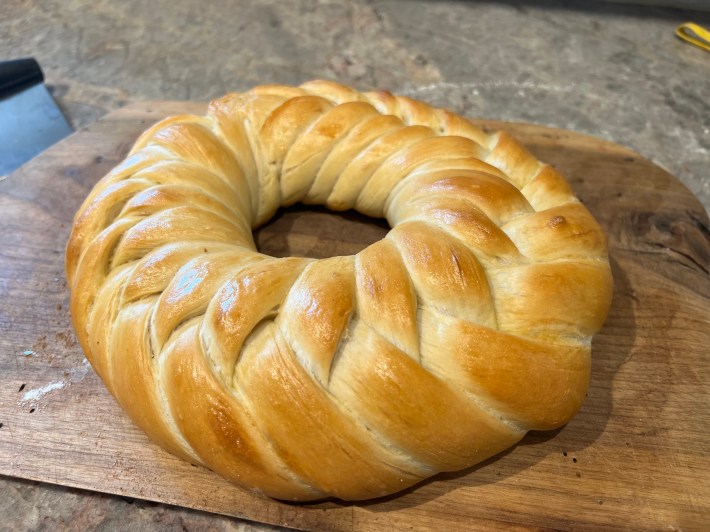
KM: Wow!!! Imagine if your dishwasher had been preheated. You could have done this perfectly, no problem.
CT: Show loaf?
KM: Here is my golden girl.

CT: To me, the color on this loaf is absolutely perfect. And you got it done inside the time limit!

KM: I feel really proud of this one! I cut into it with pure terror after it cooled a little bit, but the inside was perfect and beautiful.
CT: Yeah, mine feels very dense, but it’s hard for me to know whether that’s good or bad, because it is WONDERFUL to eat.

KM: I think they have to be dense because of the braiding! But I’m not sure. It tastes great! I have been just slathering fancy butter on it as a treat.
CT: It’s so good with butter, or swiped through some olive oil. We had it with some soupy beans ‘n greens and it was so delightful. This damn Paul Hollywood knows his way around a loaf!
KM: Yeah! Ultimately it’s kind of funny that we essentially braided a loaf of regular-ass white bread, but whatever! It was satisfying. Unfortunately, I fear next week will be a special kind of torture.
CT: I’m dreading this one! Dreading it!
KM: It’s Caramel Week, baby!
CT: A delightful thing to eat and a seasonally appropriate challenge, but truly a horrifying and calamitous thing to fling around one’s kitchen.
KM: Whatever! We can do it! I cannot wait to be Star Bakers again!
